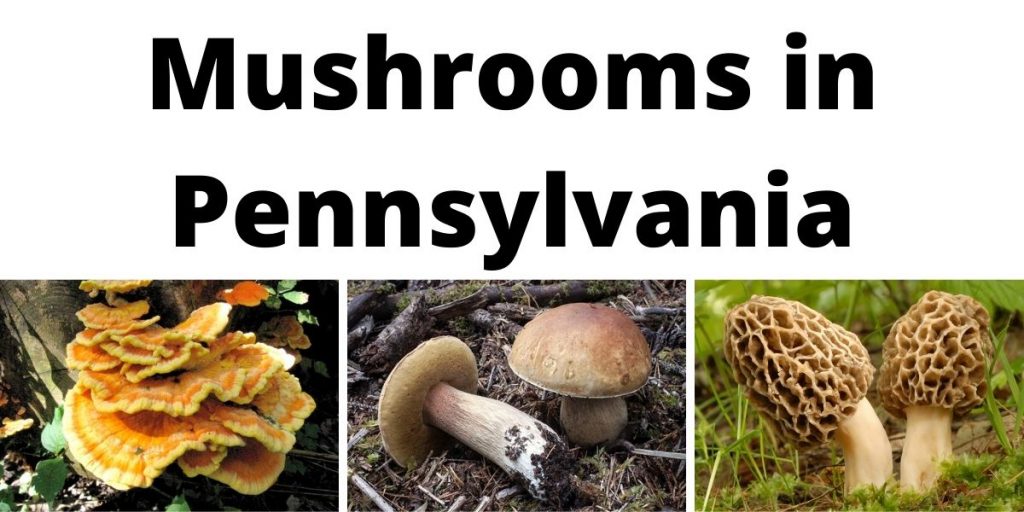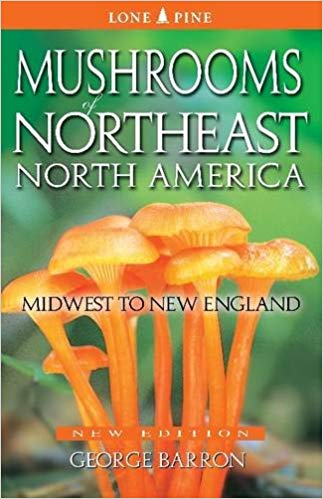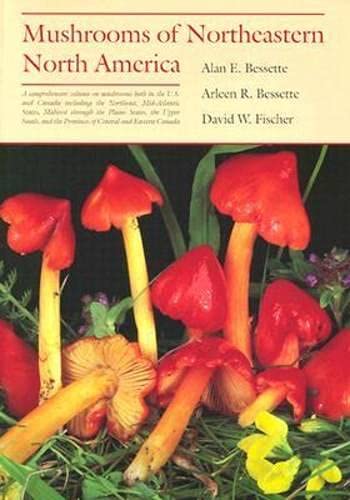Pennsylvania is not a state of dramatic extremes, except for the contrast between its natural areas and its built-up or exploited areas. It’s a good place to go looking for mushrooms of forests and farm-fields. The state does have its community of mushroom enthusiasts, and many species to be enthusiastic about.
If you intend to go looking for mushrooms it would help to have a quality knife with you and a basket/bag for your finds!
This list is meant to an introduction be sure to use a field guide, spore prints, an identification app or an experts opinion over our website!
There is no way we can discuss all the mushrooms in Pennsylvania, but we can provide a sampling.
Our Recommended Field Guides for Pennsylvania
COVER | TITLE | Header | ||
|---|---|---|---|---|
OUR #1 RATED | ||||
Edible Wild Mushrooms in Pennsylvania
It’s important to recognize that “edible wild mushroom” is seldom a simple, straight-forward designation. Most species referred to as edible must be cooked to be eaten safely. A few make some people ill even when prepared properly, though it’s not clear why. Some “species” are actually groups of closely-related look-alikes, some of which are safely edible while others are not. Plus, a person can be allergic to anything, even otherwise safe mushrooms. Complicating the whole subject is the fact that there is a lot of wrong information out there.
That doesn’t mean don’t eat mushrooms. It means learn about mushrooms in depth and THEN eat them.
King Bolete (Boletus sp.)
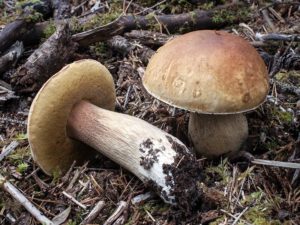
The king bolete[i] is not actually a single species. It is a group of closely-related and very similar species that used to be lumped together under the name, Boletus edulis, before the actual diversity within the group was discovered. Exactly how many species there are and where they all live is still being worked out[ii]. In any case, king boletes (also called penny bun mushroom or porcini) are very popular as table fare, though some are slightly bitter unless dried first. They can be prepared any number of different ways, plus dried and powdered king makes a flavorful addition to soups, sauces, and gravies.
Chicken-of-the-Woods (Laetiporus sp.)

Chicken-of-the-woods (also called sulfur shelf) isn’t a single species, either, but until relatively recently was thought to be. And, unlike the king bolete group, not all chickens can or should be eaten[iii].
Some are simply and wholly delicious, if properly cooked. They really do taste like chicken, hence the name. Others are tough and only the more tender margin is palatable. There have even been reported poisonings, so most likely some chickens are toxic—it’s just not entirely clear which these are, yet. The good news is that the group as a whole is so distinctive-looking that there aren’t any toxic non-chicken look-alikes.
Shaggy Mane (Coprinus comatus)
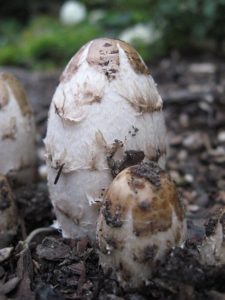
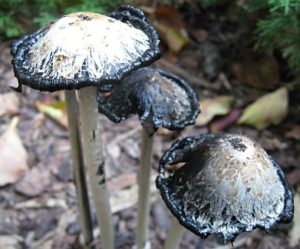
Shaggy mane[iv] has a long, narrow cap covered in large, soft, “shaggy,” scales. It is the scales that differentiate them from their closest look-alike, The Ink Cap. Both are safely edible, provided the eater does not also consume alcohol, either during the meal or for two days or so afterwards.
Curiously, these mushrooms do not release their spores as a powder, as most fungi do. Instead, the whole mushroom liquefies becoming black, spore-filled goo that drips or flows away. The lowermost edge of the cap turns to go first, then the next-lowest, as the cap gradually gets shorter and shorter, and the puddle of goo at the base grows. While the transformation to goo does not sound appetizing, and it’s true harvested mushrooms don’t keep long, shaggy mane is actually quite good, paring well with chicken or rice. The black liquid is edible, too, and makes an interesting food dye.
Giant Puffball (Calvatia gigantea)
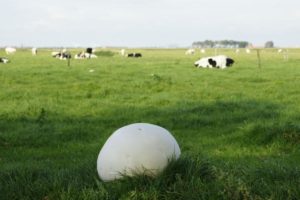
The giant puffball[v] is so huge that larger specimens can’t be mistaken for anything else. They are white, smooth-skinned, roundish or blob-like in shape, and soccer-ball sized or larger. A western giant puff also exists, but its skin is not smooth, and it generally doesn’t grow in Pennsylvania. Anyway, both giant puffs are edible[vi], as are the mid-sized puffs that could be mistaken for a small specimen.
Some smaller puffball species are poisonous (these are usually called Earthballs), and the egg stage of several species, including several dangerously toxic Amanitas, could be mistaken for a small puff as well. Even a genuine giant puff ceases to be edible once its spores start to mature and darken. Correct identification is important.
Prompt use or preservation is also important[vii]—a giant puffball is a lot of food, and it won’t keep long outside of a refrigerator. A good option is to dry extra puffball mushroom and make a powder. Puff powder has all sorts of interesting uses.
Black Trumpet (Craterellus fallax)
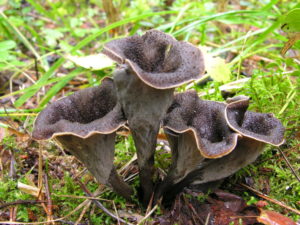
The black trumpet or horn-of-plenty[viii] looks rather like a chanterelle in shape, and indeed the trumpets and the chants are closely related. The color is indeed black or darkest gray. The flavor is mild and a little nondescript, but the scent is often very good, and the texture is interesting—thin and dry, rather like a cross between paper and rubber, yet not at all unpleasant. These are not mushrooms most people would eat alone, but added to a dish (say, of pasta or eggs) they can be quite good.
Oyster Mushroom (Pleurotus ostreatus)
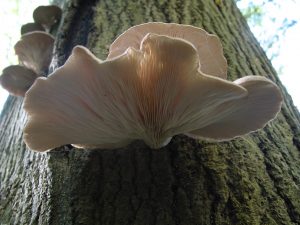
The entire Pleurotus genus can be referred to as Oyster Mushrooms as a group, and all of them have the word, “oyster” in their English names somewhere (usually with an adjective, such as pink or golden). But the phrase, “oyster mushroom” without any modifier or qualification almost always means this species, P. ostreatus. The name refers to its very vaguely oyster-like appearance, not the taste, though the delicate taste is beloved by many. It is white or whitish with either no stem or a short stem on the side, and it always grows from wood.
Morel (Morechella sp.)


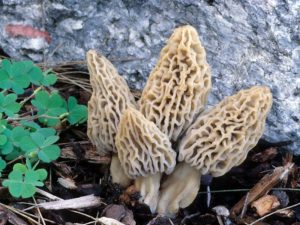
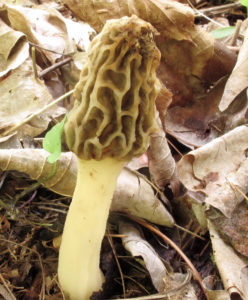
The morels are a group of famously delicious mushrooms characterized by long, narrow caps that are pitted like honeycomb. Generally, it’s pretty easy to figure out if a mushroom is a morel (and not one of the group’s superficial but poisonous look-alikes). It’s harder to tell which morel the specimen is—the genus is in the process of being redefined, and several of what were thought to be species either don’t exists or live only in Europe[ix]. However, a morel by any other name is still just as good in cream sauce.
A word of caution; uncooked morels are toxic, and some serious reactions have been reported from cooked morels. Although “everybody knows” all morels are edible, it seems that sometimes they are not. Popular Morels include Morchella snyderi, Morchella frustrata, Morchella rufobrunnea, and Morchella diminutiva.
Psychedelic Magic Mushrooms in Pennsylvania
There are places where possession and use of psilocybin (with or without the mushroom) has been either legalized or decriminalized. Pennsylvania isn’t one of them[x]. But “magic” mushrooms do grow in the state. Here is a list of the relevant species[xi]. Please do not use this information to get sent to prison.
Do not get sent to a morgue, either. While psilocybin is relatively safe (it’s not entirely safe, but what is?), many of these species have a deadly look-alike. Do not allow eagerness to lead to incaution.
Gymnopilus sp.

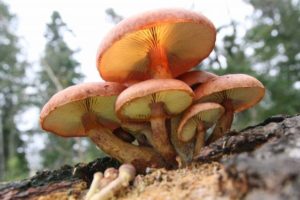

Gymnopilus is a large genus with only a few “active” members. Users report a qualitative difference between gym “trips” and those with the more popular Psilocybes, suggesting the possible presence of another mind-altering substance in addition to psilocybin. Pennsylvania’s three active gymns are G. aeruginosus[xii], G. luteofolius[xiii], and G. luteus[xiv]. All are small, yellowish-brown, and not very well known.
Panaeolus sp.
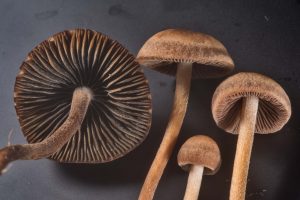
These mushrooms are called mottlegills because the spores don’t mature and darken evenly but instead in a few patches at a time. That being said, psychonauts tend to just call them pans, short for Panaeolus. Only a few mottlegills are “active,” and these are given their own genus, Copelandia, by some authorities. Pennsylvania has one of these actives. P. cinctulus, or the banded mottlegill. It is light brown, sometimes with a bluish tint. The outer edge of the cap is a different shade of brown, the band referred to in the common name. It likes horse dung or decomposing grass, and often turns up as a weed in the cultivation of other dung-loving species.
Pluteus sp.
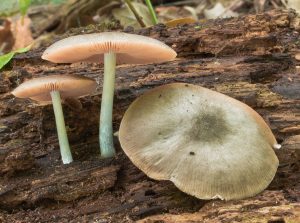
This genus is best known for its non-magic edible members, but a few are “active.” Pennsylvania has one of these, P. americanus, a pinkish gray-brown mushroom that sometimes stains blue. It eats, and fruits from, wood. It’s not often used, so not much is known about is effects.
Psilocybe sp.
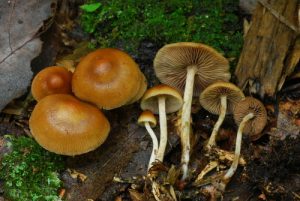
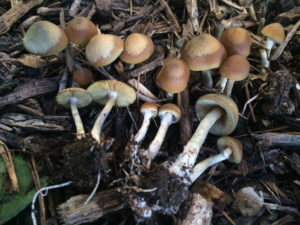
This is the genus of the famous Psilocybe cubensis, one of the best-known and most-popular “magic” mushrooms in the world. “Cubes” don’t grow in Pennsylvania (except when Pennsylvanians cultivate them), but two other Psilocybes do, P. caerulipes[xviii] and P. ovoideocystidiata[xix]. Both are commonly called blue-foot, since the base of the stem is usually rare. Both are small, brownish, and sometimes stain slightly blue if handled. Of the two, the latter is larger.
Poisonous Mushrooms in Pennsylvania
There are some people who claim that a simple rule of thumb will allow you to differentiate between poisonous and safely edible mushrooms. Do not listen to those people. Some of those who did listen to those people are dead, now. There is no shortcut to learning proper mushroom-identification skills and using them.
Toxic Amanitas (Amanita sp.)
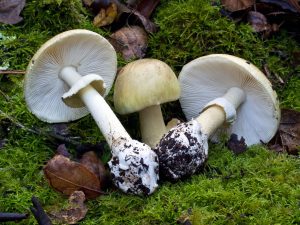
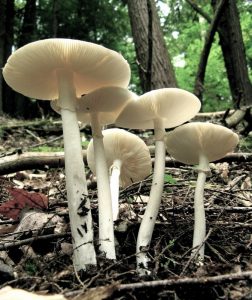
Not all Amanitas are toxic, but several of those that are can kill you. Plus, their poison has the disconcerting habit of not causing illness for up to a day, meaning that many victims don’t think the mushroom meal could be relevant and don’t tell their doctors about it. The names Death Cap and Destroying Angel both refer to multiple dangerous species, some of which occur in Pennsylvania. It’s difficult to tell these apart, and for most people unnecessary; just learn what the group looks like and never, ever eat any of them.
Unfortunately, the dangerous Amanitas have several edible look-alikes, including some fellow Amanitas, several large, white, and delicious gilled mushrooms, and most stinkhorn eggs and puffballs (Amanitas have an early, egg-like stage). Extreme caution must be taken to avoid misidentification!
Deadly Galerina (Galerina marginata)
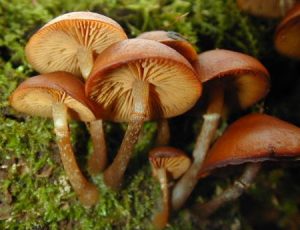
The Deadly Galerina is the reason why harvesting little brown mushrooms, or LBMs, is dangerous. Not only is the Deadly Galerina an LBM, it also shares a habitat with several of the others and sometimes grows intermixed with them. Sadly, the LBM group includes not only some popular edibles but also most “magic” mushroom species. It contains the same delayed-action poison that the toxic Amanitas do. The nightmare scenario is someone who correctly identifies a couple members of a group as safe and then harvests the entire group without realizing the group includes a second species.
Yellow Stainer (Agaricus xanthodermus)
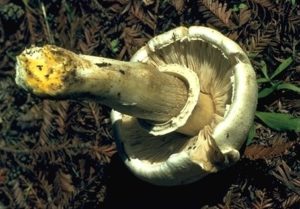
The yellow stainer[xx] is not deadly, merely unpleasant, and it does not make all people who eat it ill. The problem is that it looks so very like a large number of edible species. The claim to fame of this white mushroom is that it bruises a very obvious yellow—but “obvious” is subjective, and it’s not the only yellow-staining white mushroom. A careful examination of multiple characteristics is in order.
Fool’s Funnel (Clitocybe sp.)
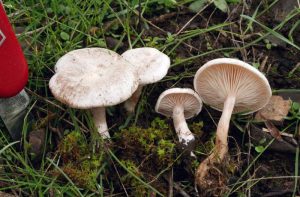
Not all Clitocybes are poisonous, but some are, and the taxonomy is a bit confused at present, so it’s not clear which name or names belong to the fool’s funnels in Pennsylvania. These[xxi] are small, white mushrooms that often form fairy rings, sometimes mixed up with edible species in the same habitat. They don’t usually kill eaters, but symptoms are scary and unpleasant, and people with an underlying health problem do sometimes die from eating this species.
Poison Pax (Paxillus involutus)

This mushroom[xxii] is occasionally called the brown chanterelle, although its resemblance to true chanterelles is slight—but perhaps no slighter than the similarity between Chants and Jack o’Lanterns, and yet people do mistake them and get poisoned. Poison Pax can also be mistaken for some milk-caps, among other potential problems. While human deaths are rare from eating this species, they do occur.
Part of the problem is that these mushrooms contain two poisons. One is destroyed by proper cooking, but the other one isn’t. And the other one is cumulative, meaning someone could eat (properly cooked) Poison Pax for months or years without difficulty before building up enough of the toxin to matter—and then very suddenly their red blood cells start coming apart. Bad.
False Morel (Gyromitra esculenta)
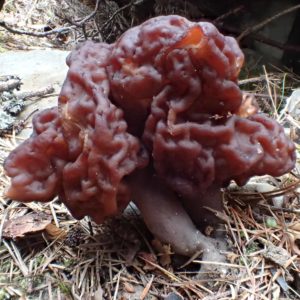
The phrase, “false morel” is generally applied to all members of the Gyromitra genus, plus sometimes other genera, though G. esculenta may be the most problematic of all of them. For one thing, it looks more like a morel than most of the others, often having a similar overall shape (though the cap it wrinkled, rather than pitted or honeycombed). For another, it is a popular edible, despite being poisonous (and sometimes deadly). The problem is two-fold. First, either human sensitivity or the mushroom itself is variable, since not everybody who eats it gets sick. Proper cooking (with plenty of ventilation, since cooking releases toxic fumes) goes a long way towards lessening the chance of illness. But this is also another cumulative poisoner, so people can eat the mushroom for years (perhaps while writing rather smug blog posts about how it’s not really toxic at all) before suddenly getting very, very sick.

My name is Austin Collins.
I've dedicated my life to Mushrooms.
I believe Mushrooms are the best kept secret when it comes to health and well being.
For that reason, I would like to share a company with you that in my opinion makes the best mushroom products on the market.
The company is called Noomadic Herbals, my favorite supplement they make is called "Mushroom Total".
I take their products every day and they have helped me think better and have more energy. Give them a try.
-Austin
References:
[i] (2011). King Bolete (Boletus edulis and others). Mushroom-Collecting
[ii] Scates, K. (2019). Trial Field Key to the Boletes in the Pacific Northwest. SVIMS
[iii] Margulies, E. (2006). Eating Chicken of the Woods. Cornell Mushroom Blog
[iv] Adamant, A. (2018). Foraging Shaggy Mane Mushrooms.
[v] Kuo, M. (2017). Calvatia gigantea. MushroomExpert
[vi] Richter, D. L., Morse, B.L. (2008). The Western Giant Puffball (Calvatia booniana A.H. Smith) in Northern Michigan. The Michigan Botanist 47
[vii] Bergo, A. (n.d). Puffball Mushrooms. Forager Chef
[viii] Volk, T. (1998)). Tom Volk’s Fungus of the Month for July 1998. Tom’s Fungi
[ix] Kup, M. (2012). The Morchellaceae: True Morels and Verpas. MushroomExpert
[x] (2021). Mushroom Laws by State 2021. World Population Review
[xi] (n.d.). Which Psilocybin Mushrooms Grow in My Area? Shroomery
[xii] (n.d.). Gymnopilus aeruginosus. Philosophy
[xiii] (n.d.). Gymnopilus luteofolius. Philosophy
[xiv] Kuo, M. (2012). Gymnopilus luteus. MushroomExpert
[xv] (n.d.). Panaeolus. Wikipedia
[xvi] (n.d.). Panaeolus cunctulus. Philosophy
[xvii] (n.d.). Pluteus americanus. Wikipedia
[xviii] (n.d.). Psilocybe caerulipes. Philosophy
[xix] Roderick (2019). Psilocybe ovoideocystidiata. Psillow
[xx] (n.d.). Agaricus xanthodermus Genev. –Yellow Stainer. First Nature
[xxi] (n.d.). Clitocybe rivulosa (Sowerby) P. Kumm. –Fool’s Funnel. First Nature
[xxii] (n.d.). Paxillus involutus (Batsch) Pers. –Brown Rollrim. First Nature

